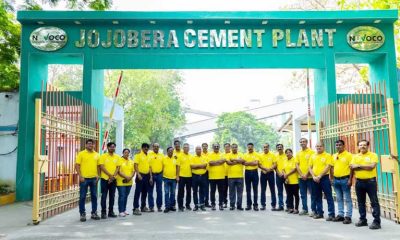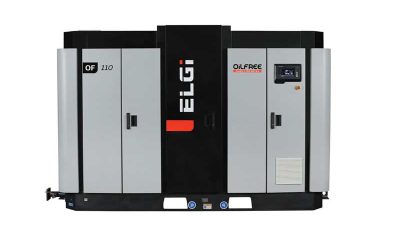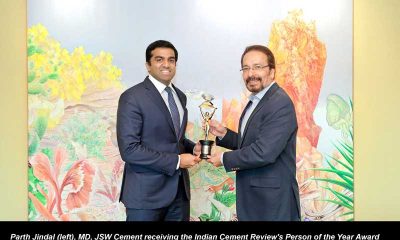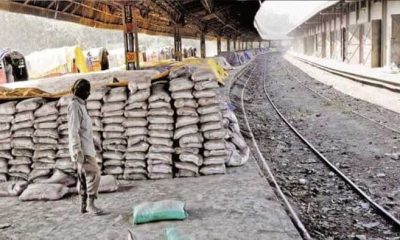Environment
Challenges Facing the Cement Industry
Published
7 years agoon
By
admin
The cement industry will have to gear up to meet fresh challenges in the future, such as upgrading its technologies for carbon capture and storage, says SAILESH MOHTA, PRESIDENT – MARKETING, WONDER CEMENT.
India is the second-largest cement producer in the world and accounts for 6.7 per cent of the world’s cement output. If you look at the statistics, cement production capacity is estimated to touch 550 million tonnes (MT) by FY20. Of the total capacity, 98 per cent lies with the private sector and the rest with the public sector.
While construction activities will keep driving demand, the Indian cement industry will need to control costs and continuously upgrade technology to stay globally competitive. The Indian cement industry has realised that strong business growth can be achieved by sustaining manufacturing in an ecofriendly manner.
There is a vital need for the cement industry to bring in new technologies and processes to achieve higher energy efficiency and to drive sustainability. In a due process of moving ahead to embrace green technologies, we should be aware of the pros and cons of greenhouse technology.
Cement Industry Analysis
Many years of industry experience have shown that the use of wastes as alternative fuels by cement plants is both ecologically and economically justified. Alternative fuel utilisation in the cement industry started in the 1980s. Starting in calciner lines, up to almost 100 per cent alternative fuel firing at the pre-calciner stage was very quickly achieved.
Energy costs and environmental concerns have encouraged cement companies worldwide to evaluate to what extent conventional fuels can be replaced by waste materials, such as waste oils, mixtures of non-recycled plastics and paper, used tires, biomass wastes, and even wastewater sludge. The clinker firing process is well-suited for various alternative fuels; the goal is to optimise process controls and alternative fuel consumption, while maintaining clinker product quality. The potential is enormous, since the global cement industry produces about 3.5 billion tonnes that consume nearly 350 million tonnes of coal-equivalent fossil and alternative fuels. This study has shown that several cement plants have replaced part of the fossil fuel used by alternative fuels, such as waste-recovered fuels.
The traditional fuels used in traditional kilns include coal, oil, petroleum coke, and natural gas. The substitution of fossil fuels by alternative fuels in the production of cement clinker is of great importance both for cement producers and for society, because it conserves fossil fuel reserves and, in the case of biogenic wastes, reduces greenhouse gas emissions. In addition, the use of alternative fuels can help to reduce the costs of cement production.
Cement Schematics
Cement entrepreneurs have to face many challenges while setting up new cement manu-facturing plants on greenfield sites. Emphasis on sustainable development is a new dimension to consider while designing the plant. The cement industry is committed to reducing the emission of Greenhouse Gasses (GHG) and to save limestone reserves and fossil fuels, while simultaneously maintaining the quality of the ambient air. All new cement plants are adopting green processes. This means they would be making blended/composite cement, using alternate fuels, using waste gases to co-generate power or to even make cement using renewable sources of power like wind and solar.
New dimension
Though not mandatory now, the industry is expected to monitor emissions of greenhouse gases. These stipulations are to be met by all proposed cement plants, green or gray. Since the cement industry is committed to the principle of sustainable development, it will willingly comply with these stipulations and do necessary planning in advance.
Green buildings
Norms have been developed for green buildings that make maximum use of sun and wind to reduce dependence on lighting and air- conditio-ning. Though not mandatory, adopting them would make the existing plants greener. The Bureau of Energy Efficiency has issued norms for lighting fixtures and cooling media to be used in refrigerators and air- conditioners. It would be best to keep these in mind right from the planning stage.
meeting these challenges
There are several real and tangible benefits of accepting the challenges and in greening the cement plants. GHG emissions can be reduced from ~0.76 t/t for OPC to 0.30 t/t for slag cement with Alternate Fuels (AF) and Waste Heat Recovery Systems (WHR). Substantial savings can be achieved by conserving reserves of limestone and fossil fuels. Capital costs of annual capacity can come down by 30 to 40 per cent even after allowing for additional costs for AF and WHR. Costs of production of naked cement excluding works also come down by 20 to 25 per cent in case of blended cements with AF and WHR.
Renewable energy
Power plants based on renewable sources such as wind and solar power will soon become an integral part of a new cement plant, making them greener as these sources of energy are totally free of GHG emissions. The necessary technology to meet these goals is now available and very reliable.
However, the main problem associated with these sources is that the generation of wind and solar power is not consistent. The capacity factor is also very low compared to that of thermal power plants. Secondly, it may not always be possible to locate wind or solar power plants close to a cement plant. The plant would have to manage several sources of electrical energy, grid, captive power plant, WHRS and power from renewable energy. A sound strategy must be in place to ensure continuity of power at optimum cost.
Future challenges
The cement industry will have to gear up to meet new challenges in the future, such as upgrading its technologies for carbon capture and storage. GHG emissions cannot be pulled down to the targeted levels merely by making blended cement and by using AF. There are technologies for separating CO2 from waste gases on the horizon. It could be used by other industries or it can also be used for making new cement substitutes such as those made by Calera Corporation.
Several cement substitutes like Calera, Novacem and Aether, are in various stages of development. All the new cement is green. The cement industry should be watchful and examine how these green products can be made in their existing production facilities.
Worldwide, the cement industry is facing growing challenges in conserving material and energy resources, as well as reducing CO2 emissions. Cement producers are striving to increase energy efficiency and the use of alternative raw materials and fuels. Therefore, the use of alternative fuels has already increased significantly, but the potential for further increases still exists. In a modern cement plant, 60 per cent of the CO2 emitted by a cement plant results from the calculations of limestone, 30 per cent from combustion of fuels in the kiln and 10 per cent from other downstream plant operations.
The main part of fuel consumption and consequently CO2 generation takes place in the calciner and clinker forming kiln. The utilisation of low-carbon content fuel with high hydrogen-to-carbon (H/C) ratio instead of conventional fossil fuels can remarkably diminish the rate of CO2 emissions in the process. In addition to producing a smaller quantity of CO2, the use of alternative fuels has been shown to improve refractory life and also reduce pressure drop in preheater tower.
The use of alternative fuels in cement plants also reduces emissions from landfills. Therefore, it has been estimated that the utilisation of this type of fuel will increase at the rate of 1 per cent per year worldwide.
Energy-efficiency improvements (use of energy-efficient equipment, process modifications, etc.), fuel switching to waste as alternative fuel and cement blending using industrial byproducts have helped decrease CO2 emissions associated with energy conversion.
About the author
Being one of the youngest Chartered Accountants in the country during his time, Sailesh Mohta had to wait for only six months to get his CA Membership. That did not stop him from scaling the heights he has reached today. With over 30 years of experience in the cement industry, his experience is not only immensely valuable, but also insightful.
Not only does he come with a strong academic background and extensive management experience, he also strongly believes in teamwork.
Prior to this, Mohta was Head of Marketing of a leading cement brand, and had a fruitful stint. He’s persistent, believes in bringing out the best in others, and is extremely sharp and focused.
He believes in living a balanced life, and truly brings a level of sportsmanship to his work, that defines his entrepreneurial skills.
Cement production in India is growing rapidly
Cement production increased at a CAGR of 6.44 per cent to 282.79 MT over FY07-16.
As per the 12th Five-Year Plan, production is expected to reach 407 MT by FY17.
In August 2016, cement production in the country increased by 3.1 per cent in comparison to 1.4 per cent in July 2016.
Concrete
Filtration can help to control climate change
Published
3 days agoon
April 16, 2024By
admin
Niranjan Kirloskar, Managing Director, Fleetguard Filters, elaborates on the importance of filtration and its profound impact on efficiency, longevity and environmental sustainability.
Tell us about the core principle of filtration.
Filtration is segregation/separation of matter by density, colour, particle size, material property etc. Filtration is of four basic types:
- Separation of solids from gas
- Separation of solids from liquids
- Separation of liquids from liquids
- Separation of Solids from solids.
As applied to engines/equipment, the main objective of filtration is to purify the impurities and provide the desired fluid or air for enhanced engine/equipment performance in turn optimising their performance and life.
Can better filtration bring productivity to the work process? How?
Better filtration can improve the quality of application performance in multiple ways. Filtration improves engine performance as it filters and prevents dirt, dust, and debris from entering into the engine. This ensures that the quality of air or fluid that reaches the combustion chamber is as per the specific requirements of optimal performance of the engine. It also extends engine life by filtering out contaminants. Efficient filtration ensures optimal performance of the engine/equipment over its entire operating life. Filtration also improves fuel efficiency as a clean filter allows for a better air-fuel mixture in the engine, thus improving combustion efficiency, which in turn results in better fuel economy. It keeps emissions under control as fuels burn more efficiently leading to lesser harmful residue in the environment. Thus, to sum up, an optimal filtration solution ensures better performance, prolonged engine life and less hazardous waste in the environment.
What is the role of technology in the process of filtration?
Innovation, research and development as well as technology play a pivotal role in catering to the ever-evolving environmental norms and growing market demands. At FFPL we have NABL Accredited labs for testing, we have ALD Labs for design, and a team of R&D experts constantly working on providing advanced solutions to cater to the evolving market needs. We have robust systems and advanced technologies that make high-quality, high-precision products. Our state-of-the-art manufacturing facilities use advanced technologies, automation, robotics and also Industry 4.0 as applicable to provide the best products to our customers. To ensure each product delivered to market is of utmost precision, advanced quality equipment such as CMM, scanning systems and automated inspection technologies for real-time monitoring and quality control during the manufacturing of filtration systems and to comply with standard quality requirements are used.
Tell us about the impact of good filtration on health and the environment.
Good filtration of equipment is to the environment what a good respiratory system is to the body. There are various benefits of an efficient air filtration system as it improves the air quality by ensuring optimum combustion of fuel thereby reducing/controlling emissions to the environment. Efficient lube filtration ensures low wear and tear of the engine thereby extending life of the engines and maintaining optimal performance over the entire operating life of the engine. Efficient fuel filtration ensures low wear and tear of expensive and sensitive fuel injection thereby ensuring perfect fuel metering resulting in best fuel efficiency and saving of precious natural resources. This efficient filtration can help to control climate change as it reduces the carbon footprint due to combustion in the environment.
Can your products be customised and integrated with other machinery?
Fleetguard Filters have been known as a leading solutions provider for decades. With relevant experience and close customer relations, we understand the market/applications requirements and develop solutions to address the pressing technical challenges our customers face concerning filtration solutions. Filters can be customised in terms of size, shape and configuration to fit specific requirements. Customised filters can be designed to meet critical performance requirements. Filtration systems can be designed to integrate seamlessly with any auto and non-auto application requirements.
What are the major challenges in filtration solutions?
Major challenges faced in filtration solutions are:
- With every emission regulation change, filtration requirements also keep changing.
- Engines are being upgraded for higher power ratings.
- Space for mounting filtration solutions on vehicles/equipment is shrinking.
- For fuel injection systems, the water separation efficiencies are becoming more and more stringent, so are particle separation efficiencies.
- Due to next level filtration technologies,filtration systems and filter elements are becoming expensive, thereby increasing TCO for customers.
- Customers prefer higher uptimes and longer service intervals to ensure lower maintenance and operating costs.
We, at Fleetguard, strive continuously to ensure that all the pains experienced by our customers are addressed with the fit to market solutions. Balancing the cost of filtration solutions with their performance and durability can be challenging, especially where the requirements of high filtration standards are required. Also, wrong disposal methods for used filters can have environmental impact.
- –Kanika Mathur

Prince Pipes and Fittings Limited, in partnership with Ambuja Foundation, has launched a comprehensive water harvesting project in Chomu district of Rajasthan as part of its CSR initiative. The project aims to address water scarcity and enhance community resilience against water-related challenges. Ambuja Foundation will focus on setting up over 50 rooftop rain rainwater harvesting systems to provide a reliable source of water for 250 people. Additionally, efforts will be made to revive 2 village ponds, creating 10,000 cubic meters of water storage capacity, and to rejuvenate groundwater by implementing check dams, farm ponds and farm bunding. The project also includes educating the local community on water conservation techniques and promoting conscious water usage. This initiative seeks to support farmers through the government’s subsidies to install sprinkle irrigation systems at a minimal cost, while also contributing to livestock strengthening and promoting community ownership.

Dr SB Hegde, Professor, Jain University, Bangalore, and Visiting Professor, Pennsylvania State University, USA, discusses how the cement sector is battling substantial carbon emissions and resource depletion, and embracing advanced technologies to mitigate its environmental impact.
In the relentless pursuit of urbanisation and infrastructure development, the cement industry finds itself at a pivotal intersection of ambition and responsibility. This foundational sector has long been synonymous with progress and growth, providing the bedrock for modern cities and industries. Yet, beneath its seemingly unyielding façade lies a profound challenge – the environmental footprint it leaves behind. Cement production, for its high carbon emissions and resource consumption, is now compelled to rewrite its narrative. The cement industry needs to become more sustainable using advanced technology. In this article, we will explore the world of cement production and discover new solutions that can change its future.
Considering traditional cement production is a major emitter of CO2, accounting for around 8 per cent of global greenhouse gas emissions. It consumes a vast amount of limestone, a finite resource, and contributes to deforestation and habitat destruction in limestone-rich regions.
Supplementary cement materials (SCMs) and creative ideas like Calcined Clay Clinker (LC3) are making a big difference. These different materials are transforming the way things are done. For example, in India, where the cement industry is one of the largest carbon emitters, LC3 technology, which incorporates calcined clays into cement, has been demonstrated to reduce CO2 emissions by up to 30 per cent and substantially decrease energy consumption during the clinker production process. By 2050, it is estimated that the implementation of such alternative materials could help the cement sector reduce its global CO2 emissions by up to 16 per cent.
The cement industry because of its energy-intensive processes, consuming approximately 5 per cent of the world’s total energy and contributing significantly to greenhouse gas emissions.
Waste heat recovery systems, a pivotal technology, are setting an example for sustainability. A case study from a cement plant in Germany showed that waste Innovations in Sustainability Dr SB Hegde, Professor, Jain University, Bangalore, and Visiting Professor, Pennsylvania State University, USA, discusses how the cement sector is battling substantial carbon emissions and resource depletion, and embracing advanced technologies to mitigate its environmental impact. heat recovery reduced energy consumption by approximately 20 per cent and cut CO2 emissions by 1.6 million tons annually. This not only demonstrates the environmental benefits but also underscores the economic advantages of such innovations.
Furthermore, the industry is adopting alternative fuels, often derived from waste materials. Lafarge Holcim, one of the world’s largest cement producers now utilizes alternative fuels in 37 per cent of its cement plants. This has resulted in an estimated reduction of 2.2 million tonnes of CO2 emissions annually, showcasing the transformative potential of sustainable fuel sources.
The electrification of kiln systems is a transformative step towards sustainability. While the shift to electrification is in its nascent stages, there are promising examples. Heidelberg Cement, a global leader in building materials, has set ambitious targets to electrify its cement production processes. By leveraging renewable energy sources, such as wind and solar, the company aims to reduce CO2 emissions by 30 per cent within the next decade. These concrete numbers underscore the industry’s commitment to low-carbon electrification.
Hybrid and flash calcination technologies offer compelling statistics as well. For instance, a pilot project using flash calcination technology in the Netherlands yielded a 25 per cent reduction in CO2 emissions compared to traditional rotary kilns. These numbers highlight the potential of disruptive technologies to reshape the cement industry.
This article is like a clear road map with real examples, explaining how the cement industry is becoming greener and more sustainable. By using technology, the cement industry wants to find a balance between moving forward and taking care of the environment. It’s showing how an industry can change to become more sustainable, strong and responsible for the future.
CURRENT TECHNOLOGIES

1. Alternative raw materials: The cement industry’s traditional reliance on limestone as a raw material is undergoing a transformation. The incorporation of alternative materials like fly ash, slag or pozzolans is a sustainable approach. For example, the use of fly ash in cement production can reduce CO2 emissions by up to 50 per cent compared to traditional Portland cement.
2. Energy efficiency: Improving energy efficiency is crucial. Waste heat recovery systems can significantly reduce energy consumption. For instance, waste heat recovery in cement plants can lead to a 20-30 per cent reduction in energy consumption.
3. Carbon Capture and Storage (CCS): CCS is a promising technology. In Norway, the Norcem Brevik cement plant has successfully demonstrated the capture of CO2 emissions, which are then transported and stored offshore. This technology can capture up to 400,000 tonnes of CO2 annually.
4. Use of alternative fuels: The shift towards alternative fuels can significantly reduce carbon emissions. For example, the use of alternative fuels in the European cement industry results in an average substitution rate of about 40 per cent of conventional fuels.
5. Blended cements: Blended cements, combining clinker with supplementary cementitious materials, can lead to lower emissions. For example, the use of slag and fly ash can reduce CO2 emissions by up to 40 per cent.
INNOVATION FOR THE FUTURE
1. Carbon Capture and Utilisation (CCU): CCU technology is still emerging, but it shows great potential. Innovations like carbon mineralisation can convert CO2 into stable mineral forms. Carbon Engineering, a Canadian company, is working on a direct air capture system that can capture one million tons of CO2 annually.
Feasible CCS technologies for the cement industry include:
a. Post-combustion capture: Capturing CO2 emissions after combustion during clinker production using solvents or adsorbents.
b. Pre-combustion capture: Capturing CO2 before combustion, often used with alternative fuels.
c. Oxy-fuel combustion: Burning fuel in an oxygenrich environment to facilitate CO2 capture.
d. Chemical looping combustion: Using metal oxides to capture CO2 during the calcination process.
e. Carbonation of alkaline residues: Capturing CO2 using alkaline residues from other industrial processes.
f. Integrated Carbon Capture and Storage (ICCS): Directly capturing CO2 from the cement production process.
g. Underground storage: Transporting and storing CO2 underground in geological formations.
h. Enhanced Oil Recovery (EOR): Injecting captured CO2 into depleted oil reservoirs.
i. Mineralisation: Converting CO2 into stable mineral forms for potential use or storage.
The cement industry can reduce emissions by adopting these technologies, but cost, energy, and infrastructure challenges must be addressed for widespread implementation. Collaboration among stakeholders is crucial for successful CCS integration.
2. Biomimicry in cement design: Researchers are exploring biomimetic materials inspired by nature. For example, a company called BioMason uses microorganisms to grow cement-like building materials, reducing energy use and emissions.
3. 3D printing of cement: 3D printing technology offers precise and efficient construction, reducing material waste. In a study, 3D-printed concrete structures used 40-70 per cent less material compared to traditional construction methods.
4. Blockchain for supply chain transparency: Blockchain technology ensures transparency and traceability. It is already being used in supply chains for various industries, including cement. By tracing the origin of raw materials and tracking production processes, it ensures sustainability compliance.
EVALUATING AND IMPLEMENTING SUSTAINABLE TECHNOLOGIES
1. Life Cycle Assessment (LCA): LCAs assess environmental impacts. For instance, a comparative LCA study found that geopolymer concrete (an alternative to traditional concrete) had 36 per cent lower carbon emissions compared to Portland cement.
2. Cost-benefit analysis: Considerations of initial investments and ongoing operational costs are paramount. Studies show that the implementation of waste heat recovery systems can pay back their initial costs in as little as two years, leading to long-term savings.
3. Regulatory compliance: Stricter emissions standards are being enforced globally. The European Union, for instance, has set ambitious emissions targets for the cement industry, mandating a 55 per cent reduction in CO2 emissions by 2030
4. Scalability: The scalability of technologies is critical for industry-wide adoption. Technologies like blended cements and waste heat recovery systems are already scalable, with global cement companies actively implementing them.
5. Stakeholder engagement: Engaging stakeholders is essential. For example, Holcim, a leading cement manufacturer, has partnered with NGOs and local communities to ensure sustainable practices and community involvement in their projects.
In conclusion, the cement industry is on a transformative path towards sustainability, driven by technological innovations. By embracing alternative raw materials, enhancing energy efficiency, and exploring cutting-edge solutions like carbon capture and utilization, the industry is reducing its environmental impact. The future holds even more promise, with biomimetic materials, 3D printing and blockchain enhancing sustainability.
Evaluating and implementing these technologies necessitates comprehensive assessments, cost-benefit analyses, regulatory compliance, scalability and stakeholder engagement. The industry’s commitment to sustainability not only addresses environmental concerns but also aligns with societal values and expectations, setting the stage for a greener and more responsible future for cement production.
REFERENCES:
1. NIST. (National Institute of Standards and Technology) Role of NIST in Sustainable Cements.
2. International Energy Agency. Cement Technology Roadmap 2018.
3. Gassnova. Longship – CO2 Capture, Transport, and Storage.
4. European Cement Association. Cembureau.
5. CSI. (Cement Sustainability Initiative) Slag Cement and Concrete.
6. Carbon Engineering. Direct Air Capture and Air To Fuels.
7. The University of New South Wales. Alternative Cement Discovery Set to Reduce Carbon Emissions.
8. BioMason. BioMason Technology.
9. NCCR Digital Fabrication. DFAB House Project.
10. IBM Blockchain. IBM Blockchain Solutions for Supply Chain.
11. ScienceDirect. Life Cycle Assessment of Geopolymer Concrete.
12. Energy.gov. Heat Recovery Technologies.
13. EU Climate Action. EU Climate Action: Climate Targets for Cement Industry.
ABOUT THE AUTHOR:

Dr SB Hegde is an industrial leader with expertise in cement plant operation and optimisation, plant commissioning, new cement plant establishment, etc. His industry knowledge cover manufacturing, product development, concrete technology and technical services.

RAHSTA to showcase cutting-edge road construction tech, says NCC Director

RAHSTA will drive road construction innovation: Sundaresan

New appointment at TMEIC

Social Impact Award for Ambuja Cements

UCWL unveils new plant in Dabok, Udaipur

Environment Ministry revises rules of solid waste management

M-sand boards new terrain

Process and quality optimization in cement plant.
Concrete: A Highly Sustainable Building Material





















